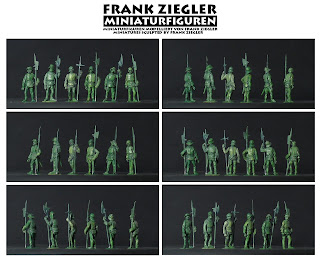Frank sent the photos of his latest figures for his Burgundian war range.
Here the official text from him:
New Pikemen/Halberdiers for the Duke
I
expand my range of the 1:72 Burgundian Army by new liveried pikemen/billmen in
halt, in a relaxed posture. These pikemen / halberdiers are only lightly
armored, comparable to my last archers. They have no vambraces only
gloves, a few have put on a bevor. And they wear simple livery clothes.
As weapons they carry a long knife and a dagger.They wear sallets and warhats.
The pikemen had the lowest status in the military hierarchy, with the shooters, although they were tactically not insignificant and bore the brunt of the battles.
The one group is also equipped with puffed sleeves, an accessory, which emphasizes their higher status with the proximity to the ducal court. In Schilling's chronicles, these shoulder pads are often depicted as a characteristic of the Burgundian troops. Although the wearing of these shoulder pads was regulated in dress code. But we can assume, that in military clothing / equipment at the end of the period of Charles the Bold, puffed sleeves had a certain spread not only with guards troops.
So let us see these soldiers not only as lightly armed infantry in the battlefield. With a lavish, elaborately decorated livery and with a glaive, poleaxe, or a Lucerne hammer, you are able to represent with these figures soldiers in guard duty for the household of a nobleman.
The pikemen had the lowest status in the military hierarchy, with the shooters, although they were tactically not insignificant and bore the brunt of the battles.
The one group is also equipped with puffed sleeves, an accessory, which emphasizes their higher status with the proximity to the ducal court. In Schilling's chronicles, these shoulder pads are often depicted as a characteristic of the Burgundian troops. Although the wearing of these shoulder pads was regulated in dress code. But we can assume, that in military clothing / equipment at the end of the period of Charles the Bold, puffed sleeves had a certain spread not only with guards troops.
So let us see these soldiers not only as lightly armed infantry in the battlefield. With a lavish, elaborately decorated livery and with a glaive, poleaxe, or a Lucerne hammer, you are able to represent with these figures soldiers in guard duty for the household of a nobleman.
The German version:
Die Pikeniere/Hellebardiere des Herzogs
Die Range der 72er Burgundischen Armee wird
nun durch weitere Figuren erweitert. Sie sind analog zu den bisherigen
Fußknechten in entspannter Haltung mit abgesetzter Wehr gestaltet. Diese
Pikeniere/Hellebardiere sind nur leicht gepanzert, vergleichbar mit meinen
letzten Bogenschützen, tragen kein Armzeug nur Handschuhe, ein paar haben ein
Bevor angelegt. Und sie tragen einfach geschnittene Livrée Überwürfe. Sie haben
Schallerhelme und Eisenhüte; als Waffen führen sie ein langes Messer und einen
Dolch.
Die einfachen Spießträger/Hellebardiere
hatten in der militärischen Hirarchie mit den Schützen den geringsten Status,
wenngleich sie taktisch nicht unbedeutend gewesen sein dürften und die
Hauptlast der Kämpfe trugen.
Die eine Gruppe ist auch noch mit Puffärmeln
versehen, ein Accessoir, was ihren gehobeneren Status mit der Nähe zum
herzöglichen Hof hervorhebt. In den Bildchroniken Schillings sind diese
Schulterpolster oftmals wie ein Charakteristikum der burgundischen Truppen
dargestellt. Das Tragen dieser aufgepufften Schulterpolster war in
Kleiderordnungen zwar reglementiert, dürfte aber zum Ende der Zeit Karls des
Kühnen hin, bei der militärischen Kleidung/Ausrüstung nicht nur bei
Gardetruppen eine gewisse Verbreitung gehabt haben.
So könnte man diese Knechte nicht nur als
leicht gerüstete Infanterie im Feld sehen. Mit einem üppig gestalteten Livre
und einer Glaive (polearm), Fußstreitaxt, oder Luzerner Hammer könnte man mit
diesen Figuren Wachen, Leibwachen im Gefolge oder im protokollarischen Dienst
darstellen.



Keine Kommentare:
Kommentar veröffentlichen